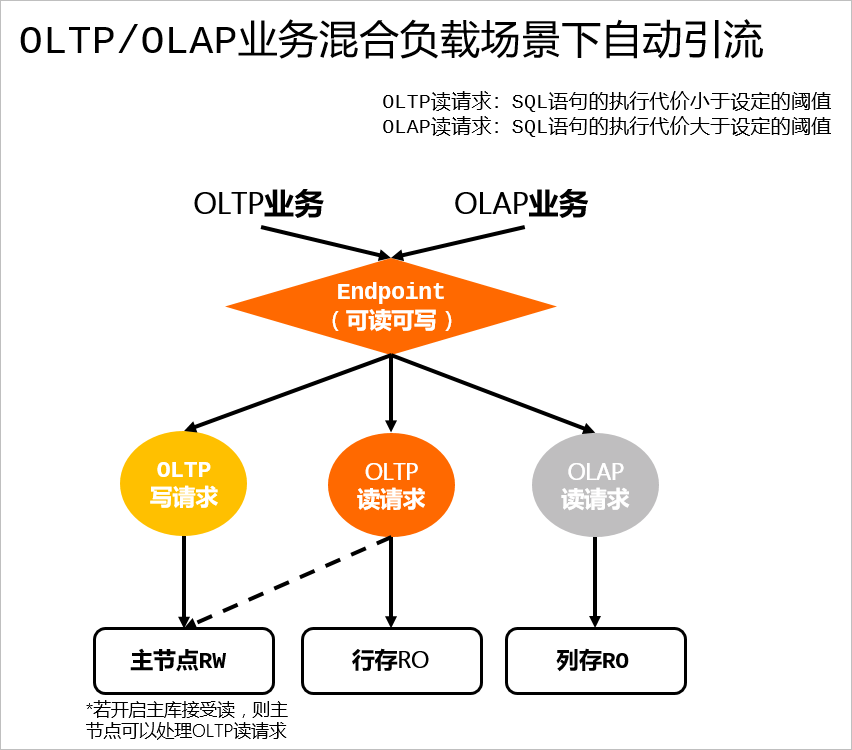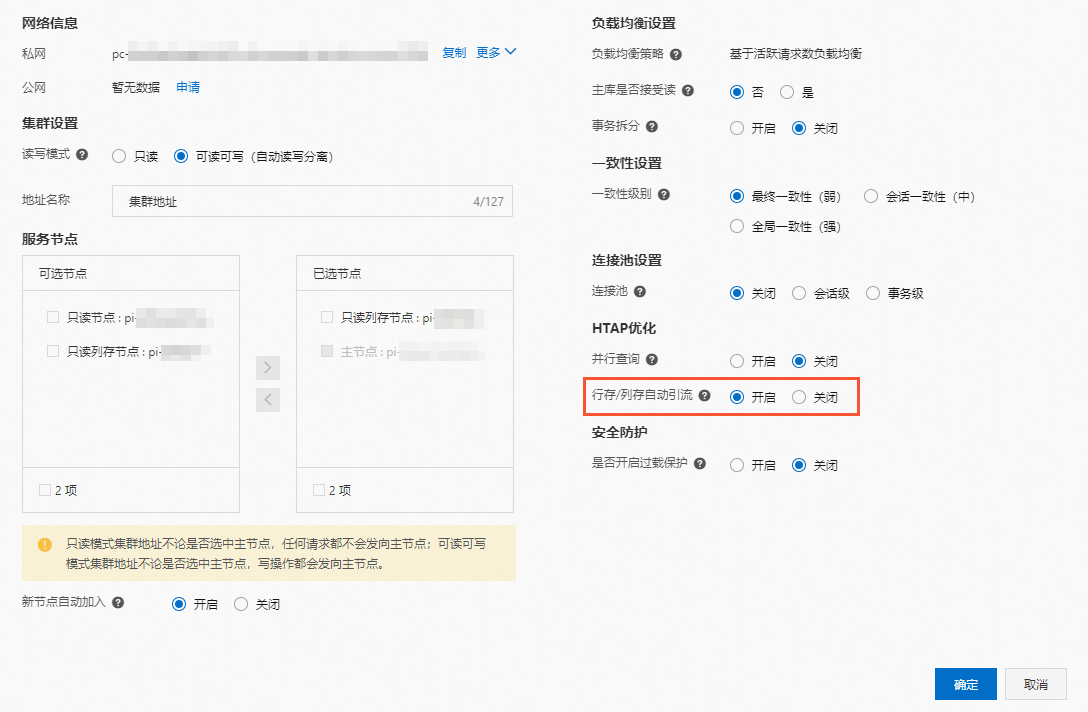如果您的業務中,OLAP類型的查詢與OLTP類型的查詢是通過同一個應用程式訪問資料庫,此時如果要實現分流,您需要設定叢集地址的讀寫入模式,並開啟自動分流功能。自動分流功能開啟後,資料庫代理基於業務流入的SQL語句的預估執行代價來實現自動分流,從而實現SQL查詢的最大效能。當SQL語句的預估執行代價超過一定值時,資料庫代理可自動將該請求分流至唯讀列存節點處理,反之該請求則由行存唯讀節點或主節點來處理。
自動分流方案說明
PolarDB MySQL版的資料庫代理功能支援將SQL語句的預估執行代價作為判斷指標,通過判斷預估執行代價是否會超過特定閾值(該閾值可配置),決定將該SQL請求分流到行存或是列存節點上處理,從而發揮出行存和列存的最佳效能。
分流規則:
OLTP類業務:一般包含讀和寫的請求。寫請求統一由主節點處理,讀請求由唯讀行存節點或主節點處理。
OLAP類業務:一般僅包含讀請求。讀請求統一由唯讀列存節點處理。
自動分流方案:
主節點和唯讀列存節點分流:由於主節點也屬於行存節點,因此也可處理OLTP類讀請求。該方案下,寫請求以及OLTP類讀請求分流至主節點,OLAP類讀請求分流至唯讀列存節點。
唯讀行存節點和唯讀列存節點分流:該方案下,寫請求依舊分流至主節點,OLTP類讀請求分流至唯讀行存節點或主節點,OLAP類讀請求分流至唯讀列存節點。

使用限制
服務節點至少包含一個唯讀列存節點和一個行存節點。
步驟1:開啟列存和行存自動引流功能
登入PolarDB控制台。
在左上方,選擇叢集所在地區。
找到目的地組群,單擊叢集ID。
在叢集基本信息頁的数据库代理企业版地區,找到目的地組群地址,單擊目的地組群位址名稱右側的配置。
根據實際情況選擇合適的读写模式。
叢集地址的讀寫入模式設定為可读可写(自动读写分离)。
叢集地址的讀寫入模式設定為只读,並且叢集地址的負載平衡原則設定為基於活躍請求數負載平衡。
在服务节点中,選擇主節點和需要參與處理請求的行存和列存唯讀節點。並在右側HTAP优化類別中,選擇開啟行存/列存自动引流。單擊確定。
說明服务节点中需要至少選擇一個唯讀列存節點。
樣本1:在下圖中,除了主節點外,服務節點還包含1個唯讀節點(即唯讀行存節點)和2個唯讀列存節點。若此時開啟自動引流功能,則:
寫請求將引流至主節點。
OLAP類讀請求引流至唯讀列存節點。
OLTP類讀請求引流至唯讀行存節點。如果負載平衡設定中將主庫是否接受讀設定為是時,也可能會引流至主節點。

樣本2:在下圖中,服務節點包括主節點和1個唯讀列存節點。若此時開啟自動引流功能後,寫請求將引流至主節點,OLAP類讀請求將引流至唯讀列存節點,OLTP類讀請求將引流至主節點。
 說明
說明可读可写(自动读写分离)模式下,無論主節點是否已被添加在服務節點中,所有寫請求只會發往主節點。
步驟2:配置自動引流閾值
開啟了列存和行存自動引流後,您需要設定SQL語句的預估執行代價閾值。閾值配置完成後,資料庫代理將此閾值作為判斷依據。若業務側請求的SQL語句的預估執行代價大於該閾值,則將該請求引流至列存節點執行;若小於該閾值,則將該請求引流至行存節點執行。
當前SQL語句的預估執行代價閾值由下表中的參數決定,您可以在叢集的参数配置頁面,根據自身業務情況修改參數的值,從而調整自動分流效果。
參數名稱 | 描述 |
loose_imci_ap_threshold | 分發至列存節點的SQL語句的預估執行代價閾值。預設值:50000。 說明 開啟列存和行存自動引流功能後,如果SQL語句的預估執行代價閾值大於50000,則路由至列存節點。 重要 PolarDB MySQL版8.0.1.1.39與8.0.2.2.23及之後的版本,該參數被棄用,分流參數統一使用 |
loose_cost_threshold_for_imci | 列存節點內部當前SQL語句的預估執行代價閾值。預設值:50000。 說明 開啟列存和行存自動引流功能後,如果SQL語句的預估執行代價閾值大於50000,則選擇列存執行計畫。否則,選擇行存執行計畫。 |
您可以通過SHOW STATUS LIKE 'Last_query_cost'命令精確查詢上一條SQL語句的預估執行代價,從而判斷如何調整上表中的參數值。
如果使用叢集地址串連資料庫,您需要在SHOW STATUS LIKE 'Last_query_cost'命令前添加HINT文法/* ROUTE_TO_LAST_USED*/,以確保能夠在正確的節點查詢到上一條語句的預估執行代價。如下:
/*ROUTE_TO_LAST_USED*/SHOW STATUS LIKE 'Last_query_cost';例如,執行以下語句,可查看上一條SQL語句的預估執行代價:
SHOW STATUS LIKE 'Last_query_cost';查詢結果如下:
+----------------------+-------+
| Variable_name | Value |
+----------------------+-------+
| Last_query_cost | 2 |
+----------------------+-------+
1 row in set (0.01 sec)從以上查詢結果可以看出,該SQL語句的預估執行代價為2。
此時若要實現將該SQL查詢分流至列存節點的列存計劃執行,則需要設定的參數值如下:
PolarDB MySQL版8.0.1.1.38與8.0.2.2.22及之前的版本
需要將loose_imci_ap_threshold和loose_cost_threshold_for_imci參數的值分別設定為1。
PolarDB MySQL版8.0.1.1.39與8.0.2.2.23及之後的版本
需要將參數loose_cost_threshold_for_imci的值設定為1。
通過HINT文法強制執行行存或列存執行計畫
如果使用行存和列存自動分流沒有達到預期效果,您可以使用HINT文法強制執行行存或列存執行計畫。
HINT文法僅對指定的SQL語句生效,對其它串連或同一個串連下的其它SQL語句沒有影響。如果在5.7.7版本之前的MySQL用戶端執行
HINT文法,則在串連資料庫引擎時需要添加--comments選項。您可以使用mysql --version命令來查看MySQL用戶端版本。
強制執行列存執行計畫。
PolarDB MySQL版8.0.1.1.38與8.0.2.2.22及之前的版本
使用資料庫代理進行行存和列存自動分流時,還可以通過
HINT文法使得資料庫代理將SQL語句強制分發至列存節點執行,而不受loose_imci_ap_threshold影響。具體方式為:在SQL關鍵字前添加/* FORCE_IMCI_NODES */。例如:/*FORCE_IMCI_NODES*/EXPLAIN SELECT COUNT(*) FROM t1 WHERE t1.a > 1;路由至列存節點的SQL語句依然會受loose_cost_threshold_for_imci影響,如果需要強制SQL語句選擇列存執行計畫,可以通過
HINT文法降低loose_cost_threshold_for_imci的值。例如:/*FORCE_IMCI_NODES*/EXPLAIN SELECT /*+ SET_VAR(cost_threshold_for_imci=0) */ COUNT(*) FROM t1 WHERE t1.a > 1;PolarDB MySQL版8.0.1.1.39與8.0.2.2.23及之後的版本
只需要通過HINT文法將參數loose_cost_threshold_for_imci設定為0即可。
EXPLAIN SELECT /*+ SET_VAR(cost_threshold_for_imci=0) */ COUNT(*) FROM t1 WHERE t1.a > 1;
說明通過
/*+SET_VAR()*/修改閾值時,需要刪掉參數首碼loose_,否則HINT語句不生效。強制執行行存執行計畫。
您可以通過
HINT文法將USE_IMCI_ENGINE的值修改為OFF,來強制SQL語句使用行存執行計畫。樣本如下:EXPLAIN SELECT /*+ SET_VAR(USE_IMCI_ENGINE=OFF) */ COUNT(*) FROM t1 WHERE t1.a > 1;